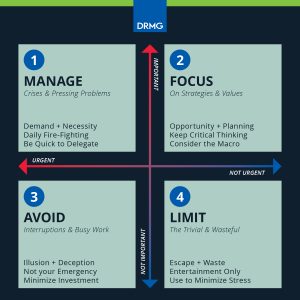Do you struggle with stressful deadlines? Are you ever unsure of what to focus on first? Do you struggle to avoid distractions and eliminating trivial tasks? Four simple quadrants can help you categorize your time to be more efficient in your everyday task management. Eisenhower’s Matrix is a tool used for effective time management, proactive task management, and productivity.
Firstly, who is this Eisenhower and why should I listen to him? Dwight D. Eisenhower was the 34th President of the United States, a WWII General (they won the war) and if he had a resume, it would say “outstanding time management skills”. He developed a foolproof way to prioritize his to-do lists and it’s still completely relevant today!
Using Eisenhower’s Matrix, you will be able to categorize tasks into the following 4 sections:
- Important and Urgent
- Important but not Urgent
- Urgent but not Important
- Not Important and not Urgent
By categorizing your tasks, you can then manage them. Each category has a specific action item associated:
Manage: Urgent Tasks Avoid: Tasks to delegate
Focus: Schedule Important Tasks Limit: Eliminate Distractions

MANAGE: Urgent & Important
These tasks are divided into two; the projects that you have left until the last minute, and the ones that come up unexpectedly. Schedule some time in your week to be prepared for these unexpected tasks.
Examples: deal with last minute urgent client request, or write a blog article for today.
FOCUS: Important & Not Urgent
Important, non urgent tasks are what you want to spend the most time on. They will lead to achieving long term goals. These are the tasks that are important and need to be done before they become urgent.
Examples: a deadline that’s due in two weeks, getting all of your client’s artwork approved, 2020 client research and planning.
AVOID: Urgent & Not Important
These tasks prevent you from achieving your goals and usually focus on someone else’s. Ask yourself if the task is yours or not. You have your own priorities, don’t let others get in the way of your goal completion. It’s hard to avoid these tasks so make time for distractions. Give yourself time each day to acknowledge the distraction but not spend too much time on it.
Example: a coworker stopping by to ask for advice on a project.
LIMIT: Not Important & Not Urgent
General day to day distractions and procrastination. Sometimes these tasks are impossible to eliminate completely so begin by minimizing and work up to eliminating them completely.
Examples: Micro-Managing Tasks, non-work related emails are examples of these tasks
Tips on Task Prioritization
Understand the difference between urgent and important. An urgent task creates a reaction, such as stress, during time-sensitive situations. Important tasks lead to achieving long term goals. Complete important tasks in a timely manner to create proactive habits and reduce urgent tasks.
Prioritize tasks by changing “how” into “what”. Instead of “how are you going to complete everything, think “what needs to be completed”. Forcing yourself to think about what needs to be done instead of how they are going to get done will put you into a proactive mindset.
Comments